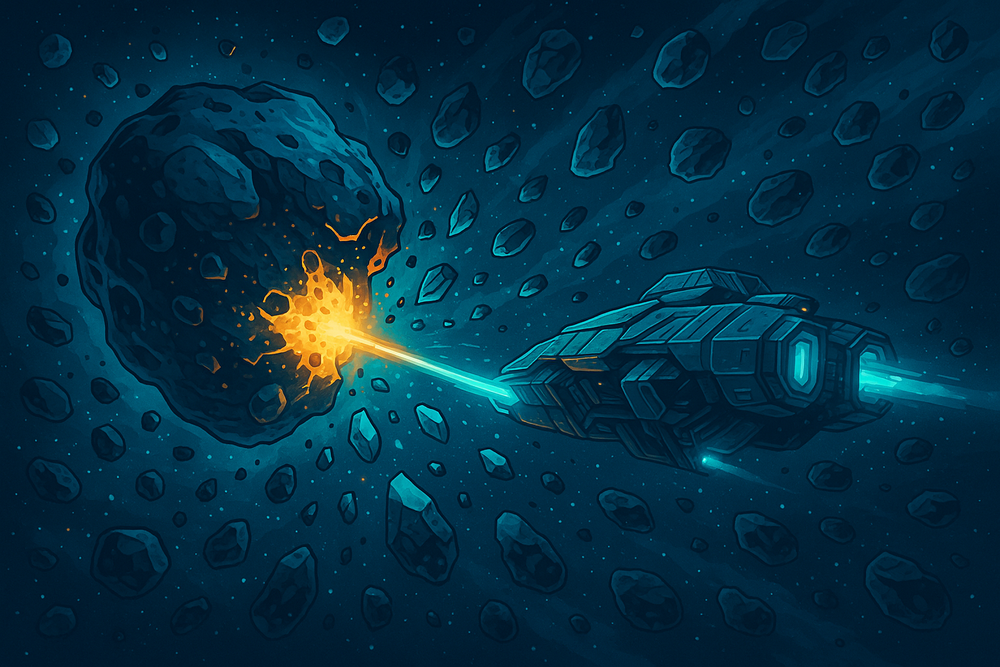Asteroid resource gathering mechanics across 3D space-themed games
Asteroid mining is a common gameplay element in many 3D space exploration games. Different titles take very different approaches, ranging from simple “shoot-and-loot” arcade mechanics to deep simulation with specialized equipment. Below, we explore how various space games handle the gathering of resources from asteroids, focusing on their specific mechanics and styles.
In Wardrome, asteroid mining takes the fast and satisfying route: point your weapons at an asteroid, blast it into pieces, and watch the resources get automatically pulled into your ship. No drones to deploy, no fiddling with refineries — just pure arcade-style fun.
We’ve put together a short video on YouTube showing the feature in action:
What follows is the research we did while deciding on this approach, exploring how other space games tackle asteroid resource gathering.
No Man’s Sky (2016) – Arcade Shoot-and-Collect
In No Man’s Sky, asteroid mining is straightforward and arcadey. While flying your starship in space, you simply shoot asteroids with your ship’s weapons (such as the Photon Cannon or a Mining Laser). When destroyed, asteroids immediately yield resources (like Tritium for fuel, or metals such as Gold, Silver, Platinum, etc.) that are automatically added to your inventory. There’s no need to manually collect floating chunks – the game just rewards you with materials upon breaking the rocks. Small common asteroids mainly give elements for refueling or trade, and occasionally rare items (e.g. “Gold Nuggets” or anomaly detectors can drop). Large asteroids (“giant space potatoes”) contain heavier metals (Iron, Nickel, Gold, etc.), and can be mined piece by piece for bigger yields. This risk-free, instant collection model makes space mining a quick way to gather resources in No Man’s Sky, especially early-game. Asteroids even respawn around the player, so you’re never far from a new target. The emphasis here is on fast, casual resource gathering rather than realism – very similar to Wardrome’s “shoot and vacuum” approach.
Freelancer (2003) – Classic Shoot and Tractor
Freelancer, a classic space trading sim, also features an arcade-like asteroid mining mechanic that was ahead of its time. In certain resource-rich asteroid fields, you can shoot the “little” asteroids with your ship’s guns, causing collectible ore chunks to drop. To collect the minerals (e.g. gold ore in the Dublin system’s gold field), you activate your ship’s Tractor Beam which pulls the floating resource pods into your cargo hold. One nuance is that using too powerful a volley can accidentally destroy the ore fragment before you tractor it, so players often fire single shots to break asteroids and then immediately scoop the loot. Not every asteroid yields a resource, but with enough targets you can fill your cargo hold in a reasonable time. This mechanic is simple: it requires manual piloting and aiming, but collection is just a button press. It captures a Wild-West prospector vibe – blasting rocks and grabbing valuables – without complex equipment. Many modern arcade-style space miners (like Everspace or Rebel Galaxy) follow this basic template of shoot, drop, and loot.
Elite Dangerous (2014) – Mining Lasers, Drones, and Core Charges
Elite: Dangerous takes a more simulation-oriented approach to asteroid mining, offering multiple tools and methods. At minimum, a player must outfit their ship with mining gear: a Mining Laser to carve off fragments, a Refinery module to process ore, and ideally Collector Limpet drones to automate collection. The simplest form of mining is “laser mining”: you fly up to an asteroid, deploy hardpoints, and fire the mining laser continuously at the surface. After a few seconds of cutting, chunks of ore break off the asteroid and float in space. You can scoop these fragments by maneuvering your ship and using the cargo scoop, but this is tricky – you have to fly slowly (under ~20 m/s) and line up each rotating chunk to ingest it. Most players instead launch Collector Limpet drones which automatically ferry nearby ore fragments into your cargo hold. The limpets allow you to keep mining continuously while they collect multiple pieces for you. Each fragment contains a mix of materials with certain percentages (e.g. a chunk might be 20% Coltan and 10% Indite); your onboard refinery accumulates these until enough is gathered to form a full unit of pure ore, which then moves to cargo. If the refinery bins fill up with unwanted low-value ore, you might need to vent them to make space for more valuable material.
Elite Dangerous also introduced advanced mining mechanics in later updates. Using a Pulse Wave Analyzer, miners can scan asteroids for special deposits. Some asteroids have fissures for Seismic Charge mining – you plant charge explosives in the rock’s fissures and detonate, cracking the entire asteroid open to reveal a motherlode of chunks. Others have surface deposits that can be knocked off with an Abrasion Blaster, or subsurface deposits you can extract with specialized missiles. These methods yield higher-value gems (like Void Opals or Low-Temperature Diamonds) but require more skill and equipment. Regardless of method, manual collection or limpets are needed to pick up the pieces. Elite’s mining is thus an active process with a simulation feel: you must manage power, positioning (staying within 500m for lasers, etc.), refinery capacity, and occasionally fend off pirates attracted by your haul. It’s far more involved than the simple auto-collection in Wardrome, appealing to players who enjoy a detailed, hands-on mining experience.
Star Citizen (Alpha) – Scanning, Precision Fracturing, and Extraction
Star Citizen features one of the most complex asteroid mining systems in games, aiming for a high degree of realism and teamwork. First, a pilot must equip a ship with a Mining Laser (or use a dedicated mining ship like the MISC Prospector or MOLE). The mining process has four stages: Prospecting, Fracturing, Extraction, and Refinement.
- Prospecting: The player uses the ship’s scanning mode to detect mineable asteroids. By pinging the area with a scanner (essentially an active radar pulse), you look for asteroids that contain resources. When a ping hits an asteroid with mineable ore, a marker appears; you fly closer and perform a detailed scan to identify the asteroid’s composition and the instability of its deposits. This tells you what minerals are present and how difficult the rock will be to break.
- Fracturing: Unlike most games where asteroids pop immediately, in Star Citizen you must fracture the large ore-bearing rock into smaller pieces first. You do this by firing the mining laser at the asteroid and carefully managing its output power. As you shoot, a meter rises indicating the rock’s energy level; the goal is to keep it in a green optimal band until the asteroid’s internal stability is overcome, causing a fracture. It’s a delicate balance – too little power and nothing happens, too much and you risk a catastrophic overcharge. Overcharge explosions can destroy a chunk of the ore (or your ship!), so mining becomes a skillful mini-game of throttle control. Once you successfully get the energy meter to stay in the sweet spot, the asteroid cracks apart into several chunks. Each chunk then can be scanned to see its composition and value.
- Extraction: Now the fractured pieces (still too large to scoop by hand) must be collected. The ship switches to an Extraction Beam mode, which is essentially a tractor beam that pulls in smaller fragments. You target a purple-highlighted mineable piece and activate the extraction beam, and it will automatically break off a collectible-sized bit and transfer it into the ship’s storage hopper. In multiplayer, one player might operate the laser while another handles tractoring. Small hand-mining is also possible for tiny “FPS-sized” mineral nodes: you use a handheld laser cutter to fracture and then pick up those pieces manually into your rucksack. Star Citizen also allows on-board Refinement on certain ships or you can take raw ore to a refinery facility. Refining (stage four) is optional, but it purifies the ore for a higher sell price. The entire cycle is designed as a mini-game of strategy and skill – you search, analyze, carefully mine, then collect. It’s quite involved compared to Wardrome’s automatic vacuuming of ore. However, it’s very rewarding when done right, and it supports cooperative roles (multiple crew on a mining ship) which few other games offer. The trade-off is that it’s time-consuming and risky, fitting Star Citizen’s goal of making mining a full profession rather than a quick chore.
EVE Online (2003) – Targeted Lasers and Industrial Scale Harvesting
In the sci-fi MMO EVE Online, asteroid mining is a fundamental industrial activity – but it plays out more like a strategic resource management task than an action sequence. All mining in EVE is done by equipping specialized mining modules on your ship (e.g. Strip Miner lasers, Ice Harvesters, etc.), then target-locking an asteroid and activating the mining laser. The laser automatically extracts ore over a period of time (one cycle), usually 60 seconds or longer. At the end of each cycle, a quantity of ore is deposited into your ship’s cargo hold or dedicated ore bay. The asteroid’s remaining ore is reduced, and the mining will continue automatically with the next cycle until the asteroid is depleted (at which point it disappears) or your hold is full. You don’t manually maneuver to collect anything – it’s all handled via the module’s effect. This means mining is as simple as locking targets and cycling lasers, but it’s intentionally a bit slow and passive, reflecting the large-scale industrial nature of the activity.
New players often start in a basic mining frigate (like the Venture) which has two lasers and a modest ore bay. As you progress, you can pilot massive mining barges or exhumers that strip-mine entire asteroid belts, or even orca and rorqual industrial command ships that boost mining for fleets. EVE also allows semi-automated mining with mining drones: you deploy drones to a target asteroid and they will mine and ferry ore back and forth to your ship continuously. Group mining operations often have a dedicated hauler or foreman handling the logistics while others focus on running lasers. Because EVE’s mining is an economy-driven, persistent activity, the mechanics emphasize efficiency (cycle yield, cargo capacity, refining output) over player reflexes. It can be relaxing and social (mining fleets chat while lasers hum) but also dangerous in low-security space where player pirates lurk. Notably, asteroids in EVE respawn on a fixed schedule, and high-value ores are found only in risky regions – pushing players to make strategic choices about where and when to mine. In short, EVE’s asteroid mining feels like operating heavy machinery: lock on, power up the beam, and watch the ore fill your hold. It’s almost the opposite of Wardrome’s quick arcade mining: EVE is slow, methodical, and often done at scale, with spreadsheets to maximize profit per hour.
X4: Foundations (2018) – Player or AI Mining in a Living Economy
Egosoft’s X4: Foundations is a single-player space sim that combines open-world exploration, trading, and empire-building. Mining in X4 can be done personally or by ordering your AI ships to do it for you. The mechanics blend aspects of both Elite and EVE styles. To manually mine, you need a ship equipped with Mining Lasers (and an ore storage hold). You fly to an asteroid field, locate a resource-rich asteroid (using the HUD or probes to find regions with minerals), and fire the mining laser to break the asteroid apart. When hit with the laser, an asteroid will shatter into collectible chunks. Small mining ships might require a few shots, while large asteroids might need sustained fire or multiple cracks. Once broken, the fragments are automatically collected by the mining ship – typically, the mining laser itself or onboard collection drones will scoop up the floating ore pieces in range. (In older X games you had to manually collect or use a special “Ore Collector,” but X4 streamlines this.) If you’re piloting, you’ll see the resources get added to your ship’s inventory once the pieces are gathered. Essentially, the mining laser doubles as a tractor for nearby fragments in X4, making the process fairly user-friendly.
What really sets X4 apart is that you can also delegate mining to AI captains as part of your economy. For example, you can buy a medium or large mining ship, equip it, and then assign it an order to “Mine Resource X in Sector Y.” The AI will fly out, scan for asteroids, mine them, and then deliver the minerals either to your station or to the nearest buyer, all autonomously. They will even repeat this indefinitely, contributing to the dynamic simulated economy of the game. As a player, you might only step in to manually mine if you enjoy the process or need a quick batch of resources; otherwise, once you can afford it, you’ll likely let hired pilots handle the dirty work. The mining mechanics themselves (fracturing rocks with lasers) aren’t very complex on the player side – no mini-game of power levels like Star Citizen – but managing fleets of miners and protecting them from enemy factions can become a strategic challenge. In summary, X4 treats asteroid mining as one economic activity among many: the physical act is straightforward, but its real importance is feeding your space stations or trade network with raw materials. It’s a more strategic/AI-driven take on mining, consistent with X4’s empire-building focus.
Space Engineers (2013/2019) – Voxel Drilling and Physics
The sandbox game Space Engineers offers a very hands-on, physics-based mining experience. Asteroids (and planet surfaces) in Space Engineers are fully deformable voxels – meaning you can literally carve into them. Players have two primary ways to mine: Hand Drills (for astronauts on EVA) and Ship-Mounted Drills. Using a drill will physically remove material from the asteroid and spawn floating ore nuggets that you can collect. For example, if you exit your ship and use a hand drill on an asteroid, you’ll see bits of rock and ore flying off; you then jetpack around and pick up the chunks into your suit inventory. It’s a very tactile, manual process reminiscent of real life EVA mining – albeit with sci-fi suits.
Most players eventually build small mining ships with one or more Drill blocks mounted on the front. Flying such a ship into an asteroid and activating the drills will grind away the rock in a cylinder shape, digging a tunnel into the asteroid. The drilled-out material is automatically collected into the drill’s internal storage (the drill block has an inventory that fills with ore as it cuts). Using the conveyor system, the ore can be transferred to cargo containers or refineries on the ship. This means a well-designed mining ship lets you bore into an asteroid and gather resources continuously, without needing to pick up pieces one by one. However, if the drill’s storage fills up or if you blast chunks off with say a warhead or rifle, you’d have to collect those pieces manually. There’s even a secondary drill mode (right-click) that destroys voxels quickly without yielding ore – used to clear unwanted stone or dig a path without cluttering your cargo.
Space Engineers’ mining is fully physics-driven: drilled tunnels persist, and you can actually mine out the entire volume of an asteroid if you want. This “voxel removal” style is more realistic in a sense – it’s like operating excavation machinery – and it’s very different from games where asteroids are indestructible objects that just spawn loot. The challenge is that managing weight, inventory, and ship stability becomes part of the gameplay (a ship loaded with ore handles differently, and mining in zero-G requires precise control). Overall, Space Engineers provides a creative, engineering-focused take on asteroid mining, where designing the right mining craft and technique is key. It’s less about quick reward and more about industrial operation, fitting the game’s survival/construction theme. (If Wardrome’s mining is going for a quick arcade feel, Space Engineers is the opposite end: a slow, player-crafted mining operation that you build and execute yourself.)
Dual Universe (2022) – Scanning, Manual Digging, and PvP Risk
Dual Universe is a unique case: a voxel-based MMO where virtually all mining was done by players manually, especially for asteroids. In Dual Universe, planetary resources eventually shifted to automated mining units, but asteroid mining remained an active, exploratory endeavor. Asteroids would spawn in the solar system each week, some in safe zones and others in PvP space. To find them, players had to use the Deep Space Asteroid Tracker (DSAT), a ship element that scans for “rumored” asteroid locations. The DSAT would give you a series of waypoints to follow (“treasure hunt” style) until you zeroed in on the asteroid’s coordinates. After some time, if not found, the asteroid’s location would even broadcast to everyone, spurring races and conflicts over the richest rocks.
Once you arrive at an asteroid (which is a big rotating voxel rock ~500m in diameter), you land and mine using your personal tool. Dual Universe’s mining tool works like a mining scanner and digger in one. You activate it and start digging into the surface, searching for ore veins within the asteroid. There is an element of “hot-and-cold” scanning: you use the tool’s directional indicators to find where the ore is buried, then drill towards it. As you carve through the voxel material, ore deposits (spheres of a certain radius) will be uncovered and you can extract the ore into your inventory. Notably, there’s no auto-collection: you literally dig and the ore goes into your suit as you mine. Also, there’s no gravity on these asteroids (or very low gravity), so players often use their jetpack to hover and drill, which can be disorienting in a dark tunnel deep inside a spinning asteroid!
High-tier asteroids (with rare T4/T5 ores) are usually in PvP zones, meaning when you go to mine, you’re vulnerable to other players ambushing you. This led to cat-and-mouse gameplay: solo miners might do quick “hit and run” extractions – jetpack in, mine a backpack full of precious ore, and jetpack out before pirates arrive. Pirate hunters might camp the last waypoint or watch for the broadcast and pounce on loaded miners. Dual Universe’s asteroid mining thus combined exploration, puzzle-solving, and PvP tension. The mechanics of digging are akin to Space Engineers (voxel removal), but done on foot and with an emphasis on scanning gameplay. There were no fancy mining lasers or drones – just you, your tool, and maybe some friends watching your back. It’s a stark contrast to Wardrome’s automated collection: in DU, miners had to locate the ore and physically extract it laboriously, often under threat. This made every liter of ore feel hard-earned. While the game had its issues, asteroid mining in Dual Universe was a memorable multiplayer experience of prospecting and risk-vs-reward.
Starfield (2023) – Ship Weapons and Mining Module
Bethesda’s Starfield incorporates asteroid mining as a secondary way to gather resources in addition to planetary exploration. In Starfield’s space gameplay, you can find asteroid belts or fields while in orbit. The basic method to mine them is simple: shoot asteroids with your ship’s weapons, just like a space combat target. Even the starting ship’s laser or ballistic weapons can crack small asteroids, causing resource chunks to be collected. Common resources like Iron, Nickel, aluminum, or water ice can be obtained from these floating rocks. In fact, early on the game prompts you to shoot asteroids to collect Tritium, which is the primary fuel for your grav drive – ensuring players learn to mine asteroids to refuel.
However, Starfield adds a twist with a special upgrade: you can acquire an Asteroid Mining Module for your ship. After completing a certain quest line at the Cydonia mining colony on Mars (involving the “Deep Mining” storyline), you are rewarded with the ability to install an asteroid mining module on your ship. This module, when activated, allows for more efficient mining of asteroids – essentially automating the process of resource extraction when you’re near asteroids. It’s analogous to having a dedicated mining laser turret that doesn’t require constant manual aiming. With the module, you might fly up to a large asteroid, activate the mining system, and watch resources get pulled in more quickly than by shooting each rock manually. This is a mid-game convenience upgrade; until then, you’ll be blasting away at space rocks the old-fashioned way.
Starfield’s approach sits somewhere between No Man’s Sky and Elite. It’s mostly arcade-style (shoot and collect) when done with regular ship guns, but the dedicated mining module gives a slight simulation flavor, implying specialized equipment. There is no complex mini-game for mining – it’s meant to be a straightforward source of extra crafting materials and fuel as you explore star systems. Notably, because Starfield has a strong RPG element, you often mine asteroids not just for raw profit but to get materials for crafting upgrades (or to complete certain side quests). In the grand scheme, asteroid mining in Starfield is a supplementary mechanic – quick, accessible, and eventually automatable, matching the game’s focus on accessible exploration. It certainly “feels” more like the arcade ease of Wardrome’s system (especially with auto-collection by the module) than a hardcore sim.
As we’ve seen, games handle asteroid mining with a huge variety of mechanics. Some, like No Man’s Sky or Freelancer, keep it quick and arcade-like – you shoot rocks and instantly gather goodies, keeping the focus on fast-paced exploration. Others like Elite Dangerous and Star Citizen turn mining into a deeper interactive experience involving scanners, specialized tools, and careful technique, making the player feel like a real space miner. Building-focused games (Space Engineers, Dual Universe) emphasize the process of mining – physically digging or constructing mining ships – which adds immersion and a sense of achievement in extracting raw materials. And strategy or MMO titles treat mining more abstractly, as an economic activity to be optimized (whether through AI automation in X4 or skill-training and fleet management in EVE Online).
For a dev like Wardrome’s, looking at these examples can be inspiring. Wardrome’s current “arcade” solution – blowing up asteroids and auto-collecting resources – is actually a tried-and-true method used in many space games for its satisfying simplicity. It ensures the player’s focus stays on action and doesn’t get bogged down in logistics. Depending on the desired experience, the developers could choose to deepen the system (for instance, adding deployable mining drones or making larger asteroids require a charged shot, etc.) or keep it light. Ultimately, asteroid mining can be as casual or as involved as a game needs – from the one-click ease of auto-loot to the elaborate dance of lasers and limpets. Space games have successfully implemented the full spectrum of mechanics we’ve researched, so Wardrome is in good company no matter which design it leans toward.



